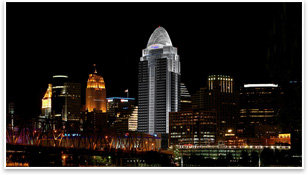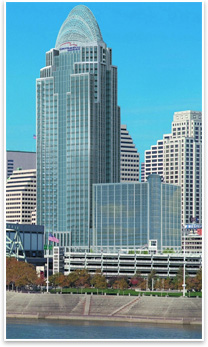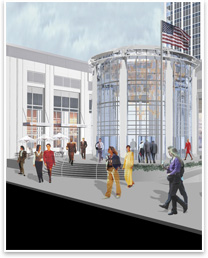Great American Building to Become Cincinnati Skyline Beacon
By Russell Boniface
Associate Editor
 How do you . . . design a LEED-certified skyscraper that will be a city landmark and skyline beacon? How do you . . . design a LEED-certified skyscraper that will be a city landmark and skyline beacon?
Summary: St. Louis-based HOK has designed the 41-story, 800,000-square-foot Great American Building at Queen City Square in Cincinnati, aka “Queen City.” The sustainable office tower will serve as a skyline beacon and be capped by a three-tiered tiara. Demolition of an existing parking structure has begun on the site, with construction of the Great American Building to begin this fall. When completed in 2011, the Great American Building will be one of the tallest buildings in Cincinnati. Western & Southern Life Insurance is the project developer. The project is seeking LEED® Silver.
HOK designed the Great American Building at Queen City Square to be a 41-story landmark for Cincinnati. The office building itself will offer 600,000 square feet, topping 800,000 square feet if you add in streetscape retail, a winter garden, and promenade. The building will overlook the city’s riverfront and have a distinctive “tiara” at the upper levels of the building. The tiara will be lighted, as will the Great American logo—a red eagle with blue script—beneath it. Both the Great American Insurance Company and Great American Financial Resources will have nearly two-thirds of the office space, including the top three floors. Great American is a subsidiary of American Financial Group, the anchor tenant that will occupy 22 floors.
 Redefining the Cincinnati skyline Redefining the Cincinnati skyline
“The Great American Building will set the character for the Cincinnati skyline,” says Tim Gaidis, Assoc. AIA, project designer, HOK. “With its crown, there is nothing like it internationally. It will be one of the tallest buildings in Cincinnati and certainly play a big part on the Ohio riverfront.”
The project had been in the HOK office for up to 18 years, says Gaidis, following market swings and a setback from the September 11 terrorist attacks. “A year ago, the anchor tenant was attracted, and that moved it forward,” he recalls. “When HOK was first charged, it was important to John F. Barrett, chairman, president, and chief executive officer of Western & Southern Life Insurance, that the building be a distinctive city landmark.
“The legend of the tiara says that HOK founding partner Gyo Obata had an image of Princess Diana’s tiara as an inspiration to create the top of the building. One of Cincinnati‘s nicknames is the Queen City, so there is a link to royalty.”
The office tower will have views in all directions. “The city itself has a lot of topography and slopes up away from the river,” Gaidis points out. “The southern side of the building faces the [HOK-designed] Great American Ballpark and takes advantage of views south to the river and across the river to the bluffs in Kentucky. Further to the west is a view of the new football stadium [Paul Brown Stadium], and views extend to the north to Broadway, a main street.”
 Great American Building seeks LEED Silver Great American Building seeks LEED Silver
As a result of being on the planning table for almost two decades, the building’s glass and metal façade has design influences from different eras, with corners and a recessed center. The façade staggers at the levels just below the tiara. “It is rooted in traditional and modern design, but the skin itself is metallic with high-performance glass,” Gaidis describes. “We are going for LEED® Silver and managing our energy efficiency. Most of the lighting for the tiara is cost-effective and energy-efficient, with internal and external flood lighting, and still keeps the tiara active on the horizon. We chose a paint that has a little bit of tooth to it, because a very glossy paint would not have picked up the light and have had more reflection, so we are using a matte type of finish on it to help grab the light and reflect it back. The tiara is also acting as a shield for some mechanical equipment on the upper levels.” The center and corners of the high-performance glass and metal façade also will light up.
The building seeks to become the greenest office tower in downtown Cincinnati. In addition to high-performance glass, a high amount of insulation, and energy-efficient lighting, the building is atop covered parking, creating a smaller footprint. A 25,000-square-foot winter garden and promenade area will feature streetscape retail and the lobby entrance. Says Gaidis:”The winter garden has a glazed section that looks over a sloping street, a 30-foot grade drop. The large glazed area connects to street level, allows for light, and will be heavily planted and landscaped.”
Gaidis says that he and HOK are looking forward to developing the Great American Building at Queen City Square. “The report on the street is positive—people are excited to have something unique to represent the city.” | 

 How do you . . .
How do you . . . Redefining the Cincinnati skyline
Redefining the Cincinnati skyline Great American Building seeks LEED Silver
Great American Building seeks LEED Silver